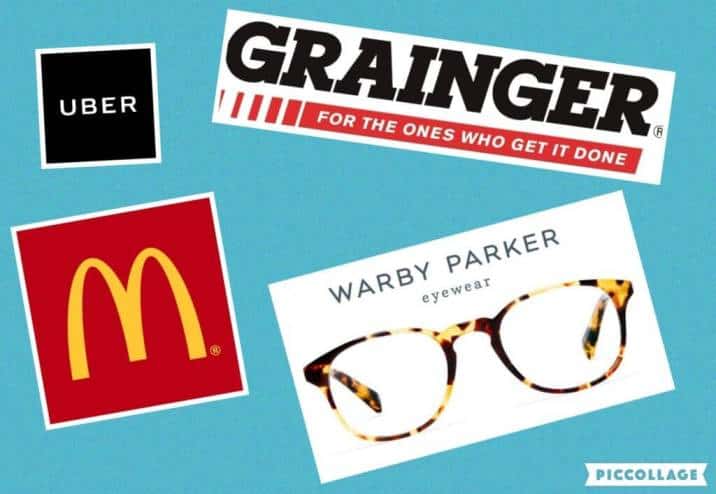I recently wrote that, when it comes to customer relationships, most businesses should NOT emulate Amazon, since Amazon’s margins are so thin.
Many of you replied with “then who SHOULD we emulate?”
So, I did a bit of thinking and came up with 4 well-known companies to model. They are:
- For margin, Warby Parker.
- For recurring revenue, Uber.
- For profitable reselling, Grainger.
- And for lifetime customer value, McDonalds.
Warby Parker. Warby Parker is an online store for prescription sunglasses and eyeglasses that since their founding in 2010 has taken the Lenscrafter “eye doctor in a mall” concept and fully “Internet-ized” it.
Trailing twelve month revenues for the company is over $100 million and the company was valued at over $1.2 billion in its last round of funding.
As they have grown, they have also had amazing success with a hybrid “bricks and clicks” model where customers can try on frames in one of their 50+ retail locations and then order them online, right in the store.
Very impressively, for a mid-priced player in the eyeglasses space, Warby’s gross margins are estimated at a healthy 60%+.
Warby manages this killer combination of moderate prices and solid margins through supply chain efficiencies on the back end and on the front end picture perfect web branding and “white glove” customer service.
How to emulate this great business? Well, first do a quick status check on the perceived value and differentiation of your offerings via running the “what would happen if I doubled my prices?” thought experiment.
If the answer comes back that sales would plummet as customers would leave for lower priced competitors, then the needed places where our offerings lack intrinsic and perceived value – because of operational inefficiencies and / or branding ineffectiveness – should become readily obvious.
And then get to work to fix those places!
For recurring revenue, Uber.
Because of their well-publicized internal troubles and management dysfunction, Uber these days is everyone’s favorite business punching bag.
But of course the company is incredibly deserving of heavy admiration and emulation for how, in just a few short years, they’ve re-engineered and become the default offering for a massive business category.
And in so doing they created a powerful recurring revenue business model based as much on their organizational design as on their marketing and technology prowess.
Uber, perhaps like no other company in history, has through its business model empowered the people that work in it to create and drive its recurring model.
These now over more than 1 million Uber drivers around the world that every day leave their homes (for no base pay!) to canvas 300+ of the world’s biggest cities and thus make it so easy for Uber customers to buy transportation from the company.
Again and again and again.
Our challenge is to similarly “crack the code” of empowering the people connected to our business – employees, contractors, partners, even vendors and customers – to “sell for us” in a way that benefits all.
Franchising is a great “old school” way of accomplishing this and Uber the ultimate 21st century technological way to do so.
Most organization designs will fall somewhere in between, but there is powerful insight to be had in reflecting on how the very structure of our business either motivates or hinders customers to “passively” transact with us, over and over again.
For profitable reselling, Grainger.
Very many companies have as their business model distributing / reselling, – i.e taking products and/or services made by someone else and then inventorying, marketing and selling them.
These kinds of businesses are under severe “disintermediation” threat, as technology allows buyers and sellers to connect directly with each other, and thus bypass “middlemen” like Grainger.
Grainger’s awesome re-selling trick – even though they sell mostly to just businesses in construction, manufacturing, and building maintenance environments – is to personalize the purchase experience in such a way that they, and not the actual maker of the products, get selling credit for the products’ “emotional” aspects – i.e. stress reduction, status enhancement, etc.
The end result is gross margins of 40%+, well above competitors in its category, and a stock up more than 300% in the past 10 years (50%+ above the S&P for this same period).
For companies that sell B2B, learning from Grainger is easy – just talk to customers not as faceless representatives but rather as living, breathing, and feeling human beings.
The Grainger Everyday Heroes video series show us exactly how to do this.
Finally, there is McDonalds for lifetime customer value.
Through its play places and its Happy Meal toy-based marketing, McDonalds establishes brand loyalty and joyful associations for customers at the youngest of ages and then continue for a lifetime.
This mindset – that we will market to and serve our customers for 50 – 60 years and more – creates a whole different conversation around our customer relationships.
Warby Parker, Uber, Grainger, McDonald’s.
Learn from them and both your customer and your bottom line will thank you.
What about You?
Do you need help marketing your products or services so they attract more customers and boost your bottom line?
Was your last new product or service launch a huge success? If so, great!
If not, send me an email to jay@jayturo.net. In the email, please give me a brief overview of your situation, and I’ll email you back my thoughts.


